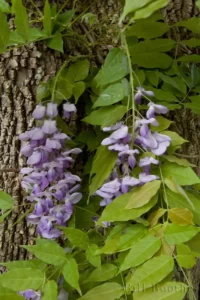The native American Wisteria (Wisteria frutescens) is the polite cousin of its exotic relatives, Chinese Wisteria (Wisteria sinensis) and Japanese Wisteria (Wisteria floribunda). The exotic Wisterias are invasive vines that can quickly overtake ecosystems.
The pea-like flowers and pods reveal that Wisterias are members of the FABACEAE or Pea family. Many skipper caterpillars including the Longtail Skipper feed on the flower, leaves and pods of Wisteria vines as well as other members of the pea family.
The flowers of the American Wisteria often are “squattier” than the more elongated and showier flowers of the invasive vines. Although the flowers of the native vine are the smallest of all the Wisteris, they are still quite charming in the home landscape.
Interestingly, American and Chinese Wisteria vies twine counter-clockwise while Japanese Wisteria twines clockwise.
The only reliable way to identify if you have a native American Wisteria is by the presence of smooth seedpods. Japanese and Chinese Wisterias have hairy seedpods.
Botanist Thomas Nuttall named the genus Wisteria in 1818, possibly in honor of American physician and anatomist Caspar Wistar (1761–1818). Due to the discrepancy of the different spellings, Nuttall may have been paying homage to Charles Jones Wister (1782-1865) who often accompanied Nuttall on botanical excursions. Or maybe it was just a typographical error.
